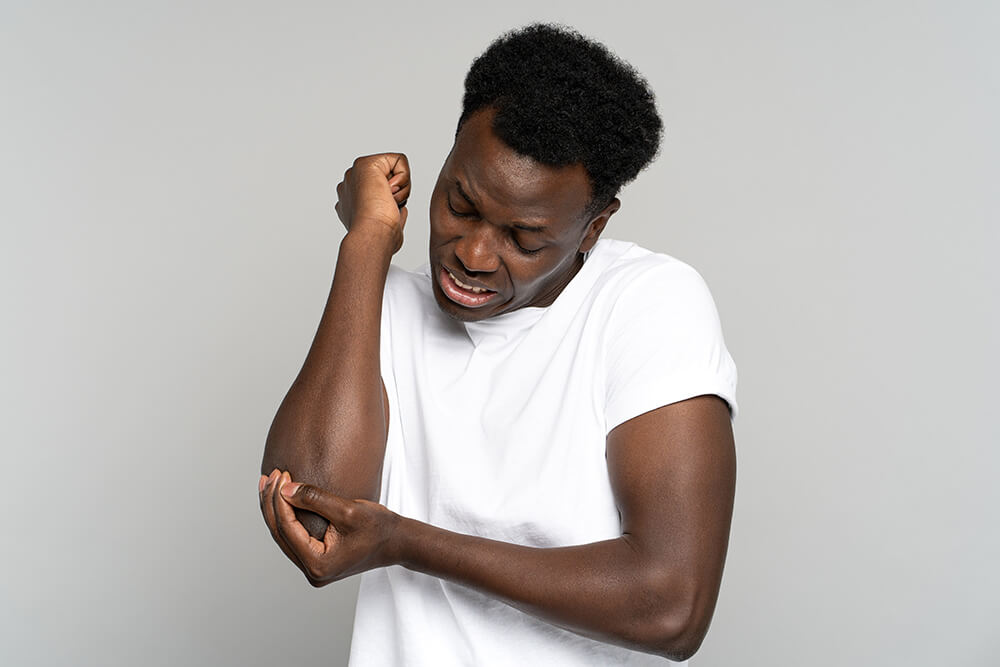Bone spurs can pop up where you don’t expect them. Once they appear, they can lead to uncomfortable symptoms like pain, stiffness, tingling and weakness. If you’re feeling any of these in your arm, you may have an elbow bone spur. Getting elbow relief can be complicated, but elbow bone spurs do have treatment options available.
Bone spurs, sometimes called osteophytes, are growths that develop on the bones in your body. The growths look and feel like bone because they are mainly made up of calcium. Though they can show up on most bones in your body, bone spurs are most commonly found in the joints like the elbow.
Elbow bone spur causes
Bone spurs can have many causes. In general, preexisting conditions and joint wear tend to make bone spurs more likely.
- Joint wear — Over time, use of a joint can lead to wear and tear on the bones and cartilage. This damage can cause bone spurs. This wearing process happens with age, which is one reason why bone spurs are more common in people older than 60.
- Osteoarthritis — Arthritis is inflammation in the joints, with several diseases and conditions falling under the term. The most common form is osteoarthritis. Osteoarthritis is a degenerative condition that causes cartilage to break down. This can lead to changes in the bone, which can cause bone spurs.
- Trauma — Bone spurs can be caused by gradual wear, but they can also be caused by singular traumatic events or injuries. If you fall and damage your elbow, the stress on the joint may cause an elbow bone spur to form.
- Inflammatory conditions — Inflammatory conditions besides osteoarthritis can cause bone spurs to develop in the joints. One such condition is rheumatoid arthritis, an autoimmune disease that causes joint inflammation. Because bone spur growth is linked to joint inflammation, these conditions can make patients more susceptible to bone spurs in the future.
Elbow bone spur symptoms
If you are experiencing discomfort in your elbow, how can you tell if it may be a bone spur instead of something else? First, you can check to see if any of the bone spur causes fit your situation. If you have arthritis or have recently injured your elbow, you may be more likely to develop bone spurs. In addition to this, you can see if your symptoms match with patients who suffer from bone spurs:
- Pain — The most common symptom of bone spurs is joint pain. This pain can range from mild to severe, depending on the size and location of your bone spurs. Large bone spurs can press hard on your nerves and muscles, causing serious pain.
- Stiffness — As bone spurs grow, they can limit your range of motion. You may feel the affected joint get stiff, and moving your arm can get more difficult. With elbow bone spurs, you may have trouble extending your arm into a straight line.
- Tingling — Bone spurs sometimes cause nerve compression or pinching. When this happens, you may experience a tingling sensation in the joint. Nerve compression can also lead to a feeling of numbness.
- Weakness — When bone spurs are severe enough, they can cause weakness in your joints. An elbow bone spur may damage or block the joint so much that the joint feels too weak to bend. Joint weakness can make daily activities tough to accomplish.
Elbow bone spur treatment options
Bone spurs can be a serious ailment, leading to severe pain and immobility if left untreated. With proper treatment, though, it is possible to manage the symptoms and improve joint function. Treatment options for bone spurs include:
- Medication — Pain medications may be prescribed to help alleviate pain caused by your elbow bone spurs. To minimize the long-term effects of the bone spurs, your doctor may suggest steroid injections. These can reduce inflammation in the target area, alleviating your bone spur symptoms.
- Surgery — Before considering surgery, you should consult with a medical professional to make sure it is the best choice for your condition. Arthroscopy, a procedure where bone spurs are removed through small incisions, is usually reserved for cases where the bone spurs actively threaten the patient’s health. In many cases, bone spurs can be managed through noninvasive approaches.
- Physical therapy — Physical therapy is a common treatment for elbow bone spurs. The first priority here is to use therapeutic techniques to get rid of the pain as soon as possible. After this, your physical therapy specialist can help you build up strength and flexibility so that you can maintain a pain-free life.
Find treatment for your elbow bone spurs at Whatcom Physical Therapy
At Whatcom Physical Therapy, we put your quality of life first. Under the guidance of a professional, you can experience a range of therapeutic techniques designed to improve joint function and reduce symptoms. In addition to strengthening and flexibility exercises, manual therapy and electrical stimulation can be effective in treating bone spurs.
Contact our team today for more information or to schedule an initial appointment for your bone spur treatment.






